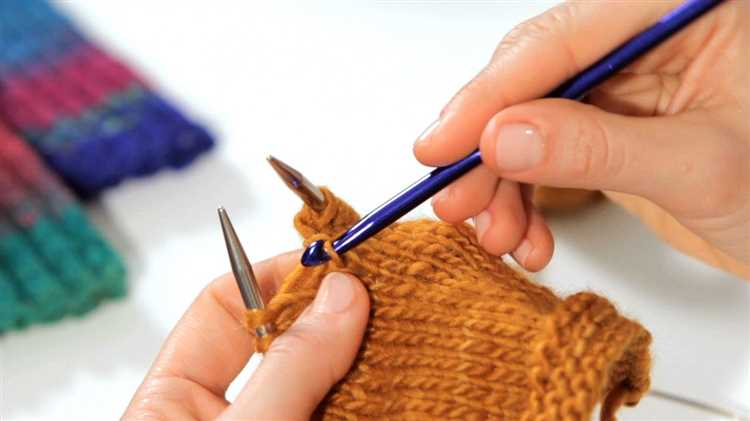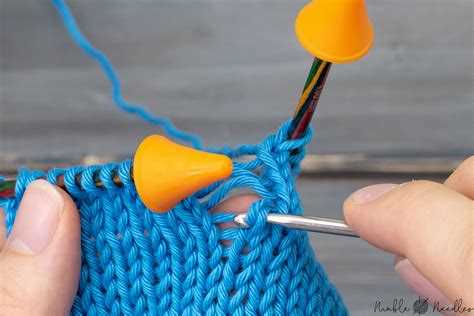If you enjoy knitting, you’ve likely experienced the frustration of dropping a stitch. It’s a common mistake that can happen to even the most experienced knitters. But don’t worry – fixing a dropped stitch is easier than you think! In this step-by-step guide, we’ll show you how to easily fix a dropped stitch and get your project back on track.
The first step to fixing a dropped stitch is to identify the problem. Look for a stitch that has slipped off the needle and is hanging loose. It’s important not to panic – remember that knitting is a forgiving craft, and mistakes can be easily corrected. Take a deep breath and let’s get started!
Once you’ve identified the dropped stitch, use a crochet hook or a spare knitting needle to pick up the stitch. Insert the crochet hook or needle into the dropped stitch from the front or back, depending on the pattern. Use your hook or needle to catch the working yarn and pull it through the stitch. This will create a new loop on your crochet hook or needle.
Next, carefully transfer the new loop back onto the knitting needle. Make sure that the loop is not twisted and that it sits correctly on the needle. It’s important to pay attention to the tension of the stitch – it should match the tension of the surrounding stitches. Adjust the tension if necessary.
Repeat this process for any other dropped stitches in your project. Take your time and be patient – fixing dropped stitches is a skill that improves with practice. Once all the dropped stitches are fixed, you can continue knitting as normal. Remember to take breaks and enjoy the process – knitting is meant to be a relaxing and enjoyable hobby!
Pro Tip: If you’re working on a complex pattern or intricate stitch, it’s a good idea to use markers or safety pins to mark the rows where you’ve dropped a stitch. This will make it easier to find and fix the mistakes.
Now that you know how to fix a dropped stitch, you can tackle any knitting project with confidence. Don’t let mistakes deter you from continuing – they are simply opportunities to learn and improve. Happy knitting!
Identify the Drop Stitch
Before you can fix a drop stitch, you need to identify it in your knitting. A drop stitch is a stitch that has been inadvertently dropped off the knitting needle, causing it to unravel and create a visible hole or loose loop in your knitting. It is important to catch and fix dropped stitches as soon as possible to prevent further unraveling and to maintain the integrity of your knitting project.
To identify a drop stitch, carefully examine your knitting piece and look for any holes or loops that seem out of place or different from the surrounding stitches. You may notice a vertical strand of yarn hanging down where the stitch has dropped.
It is also helpful to count your stitches periodically as you work on your knitting project. If you notice that the stitch count is off or if you see a discrepancy in the pattern, it is likely that you have a dropped stitch that needs to be fixed.
If you are using a pattern, refer to the pattern instructions to determine the correct stitch count and placement of each stitch. This can help you identify any dropped stitches and understand how they should be fixed.
Tip: Marking your dropped stitches with a stitch marker or piece of contrasting yarn can make them easier to locate and fix.
Gather the Necessary Tools
Before you begin fixing a drop stitch in your knitting project, it’s important to gather the necessary tools. These tools will help you correct the mistake and ensure that your finished project looks clean and professional. Here are the tools you will need:
- Tapestry needle: A tapestry needle, also known as a yarn needle, is a blunt-tipped needle used to weave yarn tails and fix mistakes in knitting.
- Crochet hook: A crochet hook is useful for picking up dropped stitches and working them back into the fabric.
- Stitch marker: A stitch marker can be used to mark the location of the dropped stitch, making it easier to identify and fix.
- Scissors: Scissors are necessary for cutting yarn tails and tidying up any loose ends.
- Stitch holder or spare needle: If you need to transfer stitches to fix the drop stitch, a stitch holder or spare needle will come in handy.
Having these tools on hand will make the process of fixing a drop stitch much easier and more efficient. Before you start, make sure you have all the necessary tools readily available.
Insert a Crochet Hook
Once you have identified the dropped stitch in your knitting, it’s time to insert a crochet hook to fix it. This method requires using a crochet hook that is the same size or slightly smaller than the knitting needles you were using for your project.
Before starting, it’s a good idea to lay your knitting flat on a table or another surface so that it’s easier to work with.
- Identify the dropped stitch and make sure you know which row it belongs to. This will help you properly pick up the stitch.
- Insert the crochet hook from front to back into the stitch directly below the dropped stitch.
- Gently and carefully pull the dropped stitch through the stitch below, creating a loop on your crochet hook.
- Once you have the loop on your crochet hook, insert it back through the stitch on your knitting needle, pulling the loop through.
- Transfer the stitch from the crochet hook back onto the knitting needle.
It’s important to note that you may need to adjust the tension of your stitches after fixing the dropped stitch to ensure it matches the rest of your project. Once you have inserted the crochet hook and pulled the stitch through, take a moment to check the tension and adjust as needed.
Continue working through your knitting rows, repeating these steps for any additional dropped stitches you encounter. Remember to take your time and be patient as you work to fix the dropped stitches. With practice, this skill will become easier and you’ll be able to quickly fix any mistakes that arise in your knitting projects.
Gently Pull the Dropped Stitch Up
Once you have identified the dropped stitch, it’s time to gently pull it back up to the correct row. This can be done using a crochet hook or a knitting needle.
Step 1: Insert the crochet hook or knitting needle into the dropped stitch from left to right, making sure to catch the yarn.
Step 2: Gently pull the crochet hook or knitting needle upwards, bringing the dropped stitch back to the correct row. Be careful not to pull too hard or the stitch may become tighter than the surrounding stitches.
Step 3: Once the dropped stitch is back in place, give it a tug to ensure it is secure. It should blend in seamlessly with the surrounding stitches.
Note: If you are having trouble picking up the dropped stitch, you can use a crochet hook to pick up the stitch directly below the dropped stitch, and then lift it up to the correct row.
Step 4: Continue knitting or purling as normal, making sure to keep an eye on your stitches to avoid dropping any more stitches.
Tip: To prevent dropped stitches in the future, consider using stitch markers to help keep track of your stitches and regularly check your work for any mistakes.
By following these simple steps, you can easily fix a dropped stitch in your knitting and continue working on your project without any noticeable flaws.
Fix Any Loose Stitches
If you notice any loose stitches in your knitting, it’s important to fix them before they unravel further and potentially ruin your entire project. Here are some steps to fix any loose stitches:
- Identify the loose stitch: Carefully examine your knitting to identify any stitches that look loose or out of place. Loose stitches often appear larger or more elongated than the surrounding stitches.
- Secure the loose stitch: Once you’ve identified the loose stitch, gently pull it to bring it back into the correct position. Use your fingertips to manipulate the stitch and tighten it up. Be careful not to pull too tightly, as this can cause the surrounding stitches to become tight and distort the overall fabric.
- Correct any tension issues: If the loose stitch was caused by tension issues, such as knitting too loosely or tightly, adjust your tension as necessary. This may involve knitting more evenly or using different needles to achieve the desired tension.
- Weave in the loose ends: If the loose stitch was caused by a loose end that was not properly woven in, take the time to weave in the loose end securely. Use a tapestry needle to thread the loose end through the surrounding stitches, ensuring it won’t come loose with wear or washing.
- Block your knitting: After fixing any loose stitches, it’s a good idea to block your knitting. Blocking involves wetting or steaming your finished piece to even out the stitches and give it a professional finish. This can help further secure any loose stitches and ensure your project looks its best.
Reinsert the Dropped Stitch
After identifying and securing the area where the stitch is dropped, it’s time to reinsert the dropped stitch back onto your knitting needles. Follow these steps:
- Hold the knitting needles correctly: Make sure you have one knitting needle in each hand, with the working yarn on your right-hand side.
- Locate the dropped stitch: Look for the loop where the stitch has been dropped. It should be slightly loose and hanging down.
- Insert the left-hand needle: With your left-hand needle, insert it from the back to the front through the dropped stitch loop. The left-hand needle should be behind the right-hand needle.
- Grab the working yarn: Reach over the right-hand needle with your right hand and grab the working yarn.
- Pull the working yarn through: Pull the working yarn through the dropped stitch loop gently, creating a new stitch on the left-hand needle.
- Move the new stitch: Slip the new stitch from the left-hand needle onto the right-hand needle, completing the reinsertion process.
- Continue knitting: Once the dropped stitch has been reinserted, continue knitting as normal. Ensure that you don’t twist or drop any other stitches while doing so.
By following these steps, you should be able to successfully reinsert a dropped stitch in your knitting project. Remember to take your time and be gentle with the yarn to avoid any further issues.
Continue Knitting
Once you’ve fixed the dropped stitch, you can continue knitting as normal. Here’s what to do:
- Make sure the fixed stitch is secure and properly positioned on the needle.
- Continue knitting the next stitch in the pattern.
- Repeat the knitting process for each stitch until you reach the end of the row.
- If you need to repeat the pattern for multiple rows, continue knitting following the pattern instructions.
Remember to keep an eye out for any other dropped stitches as you continue knitting. It’s always best to catch and fix them as soon as possible to avoid any mistakes or unraveling.
If you’re unsure about how a specific stitch should be worked or need assistance with the pattern, refer to the knitting instructions or consult with a more experienced knitter.
Enjoy the rest of your knitting project!
Block Your Finished Project
After fixing a drop stitch in your knitting project, it’s important to block the finished piece to give it a polished and professional look. Blocking smooths out the stitches, evens out the tension, and helps the project lay flat.
Here’s a step-by-step guide to blocking your finished project:
- Prepare the materials: You will need blocking mats or a clean towel, rustproof T-pins, a spray bottle filled with water, and a tape measure.
- Wet your project: Gently mist your project with water using the spray bottle. Make sure the entire piece is evenly moistened, but not soaking wet.
- Arrange the blocking mats: Lay out the blocking mats or towel on a clean, flat surface. The mats should be large enough to accommodate your project.
- Stretch and pin the project: Carefully lay your project on the blocking mats, shaping it to the desired dimensions. Use your hands to gently stretch the fabric, pulling it into shape. Secure the edges of the project to the blocking mats using the rustproof T-pins.
- Measure and adjust: Use a tape measure to ensure that your project is the correct dimensions. Make any necessary adjustments by stretching or reshaping the fabric.
- Allow to dry: Leave your project to dry completely. This can take anywhere from a few hours to overnight, depending on the thickness of the yarn and the humidity in your environment.
- Remove the pins: Once your project is fully dry, carefully remove the T-pins from the blocking mats.
Blocking is an essential step for achieving a professional finish in your knitting projects. By following these steps, you can ensure that your finished piece looks its best and retains its shape over time.
Note: Before blocking, always check the care instructions for your specific yarn to ensure that blocking is recommended.
FAQ:
What is a drop stitch in knitting?
A drop stitch in knitting is a mistake where a stitch is accidentally dropped from the needle resulting in a long loop or ladder in the knitting.
Why does a drop stitch happen in knitting?
A drop stitch in knitting can happen due to various reasons such as inattentiveness, accidentally catching the yarn while knitting, or incorrect handling of the knitting needles.
Is it possible to fix a drop stitch in knitting?
Yes, it is possible to fix a drop stitch in knitting. There are different methods to fix it depending on the severity of the mistake.
What should I do if I find a drop stitch in my knitting?
If you find a drop stitch in your knitting, it is important to not panic. You can carefully unravel the knitting to the level of the mistake and pick up the dropped stitch with a crochet hook or knitting needle.
Can a dropped stitch ruin the entire knitting project?
A dropped stitch can lead to unraveling of the knitting if left unfixed, but with proper attention and prompt fixing, it can be easily corrected without ruining the entire project.
Are there any preventive measures to avoid drop stitches while knitting?
There are some preventive measures to avoid drop stitches while knitting such as double-checking the stitches after each row, ensuring the stitches are properly secured on the needle, and knitting in a distraction-free environment.


